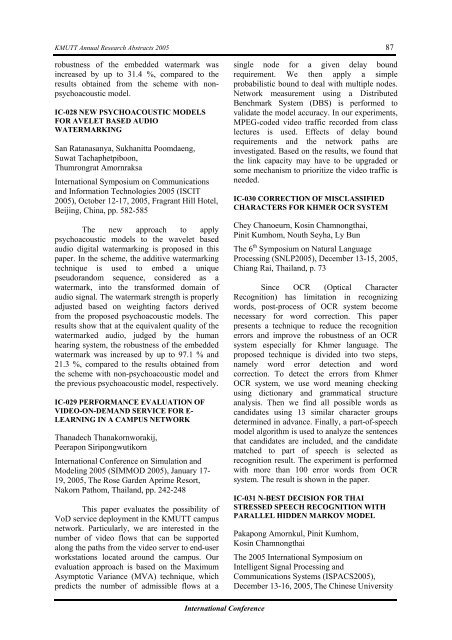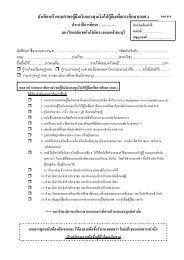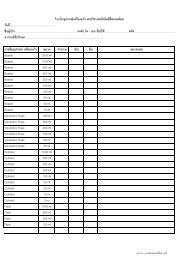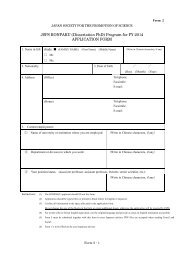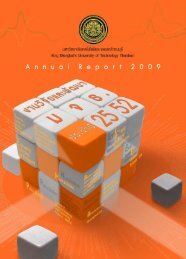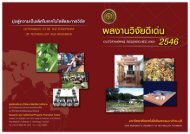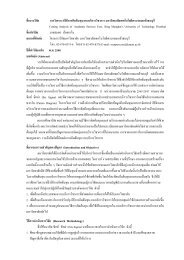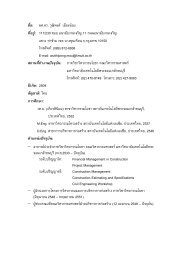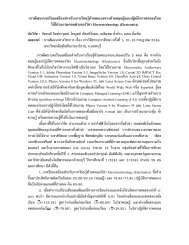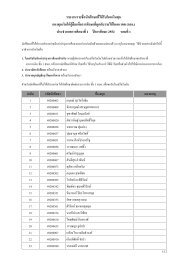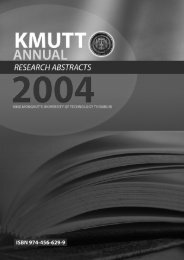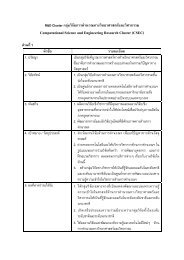Create successful ePaper yourself
Turn your PDF publications into a flip-book with our unique Google optimized e-Paper software.
KMUTT Annual Research Abstracts 2005<br />
robustness of the embedded watermark was<br />
increased by up to 31.4 %, compared to the<br />
results obtained from the scheme with nonpsychoacoustic<br />
model.<br />
IC-028 NEW PSYCHOACOUSTIC MODELS<br />
FOR AVELET BASED AUDIO<br />
WATERMARKING<br />
San Ratanasanya, Sukhanitta Poomdaeng,<br />
Suwat Tachaphetpiboon,<br />
Thumrongrat Amornraksa<br />
International Symposium on Communications<br />
and Information Technologies 2005 (ISCIT<br />
2005), October 12-17, 2005, Fragrant Hill Hotel,<br />
Beijing, China, pp. 582-585<br />
The new approach to apply<br />
psychoacoustic models to the wavelet based<br />
audio digital watermarking is proposed in this<br />
paper. In the scheme, the additive watermarking<br />
technique is used to embed a unique<br />
pseudorandom sequence, considered as a<br />
watermark, into the transformed domain of<br />
audio signal. The watermark strength is properly<br />
adjusted based on weighting factors derived<br />
from the proposed psychoacoustic models. The<br />
results show that at the equivalent quality of the<br />
watermarked audio, judged by the human<br />
hearing system, the robustness of the embedded<br />
watermark was increased by up to 97.1 % and<br />
21.3 %, compared to the results obtained from<br />
the scheme with non-psychoacoustic model and<br />
the previous psychoacoustic model, respectively.<br />
IC-029 PERFORMANCE EVALUATION OF<br />
VIDEO-ON-DEMAND SERVICE FOR E-<br />
LEARNING IN A CAMPUS NETWORK<br />
Thanadech Thanakornworakij,<br />
Peerapon Siripongwutikorn<br />
International Conference on Simulation and<br />
Modeling 2005 (SIMMOD 2005), January 17-<br />
19, 2005, The Rose Garden Aprime Resort,<br />
Nakorn Pathom, Thailand, pp. 242-248<br />
This paper evaluates the possibility of<br />
VoD service deployment in the KMUTT campus<br />
network. Particularly, we are interested in the<br />
number of video flows that can be supported<br />
along the paths from the video server to end-user<br />
workstations located around the campus. Our<br />
evaluation approach is based on the Maximum<br />
Asymptotic Variance (MVA) technique, which<br />
predicts the number of admissible flows at a<br />
single node for a given delay bound<br />
requirement. We then apply a simple<br />
probabilistic bound to deal with multiple nodes.<br />
Network measurement using a Distributed<br />
Benchmark System (DBS) is performed to<br />
validate the model accuracy. In our experiments,<br />
MPEG-coded video traffic recorded from class<br />
lectures is used. Effects of delay bound<br />
requirements and the network paths are<br />
investigated. Based on the results, we found that<br />
the link capacity may have to be upgraded or<br />
some mechanism to prioritize the video traffic is<br />
needed.<br />
IC-030 CORRECTION OF MISCLASSIFIED<br />
CHARACTERS FOR KHMER OCR SYSTEM<br />
Chey Chanoeurn, Kosin Chamnongthai,<br />
Pinit Kumhom, Nouth Seyha, Ly Bun<br />
87<br />
The 6 th Symposium on Natural Language<br />
Processing (SNLP2005), December 13-15, 2005,<br />
Chiang Rai, Thailand, p. 73<br />
Since OCR (Optical Character<br />
Recognition) has limitation in recognizing<br />
words, post-process of OCR system become<br />
necessary for word correction. This paper<br />
presents a technique to reduce the recognition<br />
errors and improve the robustness of an OCR<br />
system especially for Khmer language. The<br />
proposed technique is divided into two steps,<br />
namely word error detection and word<br />
correction. To detect the errors from Khmer<br />
OCR system, we use word meaning checking<br />
using dictionary and grammatical structure<br />
analysis. Then we find all possible words as<br />
candidates using 13 similar character groups<br />
determined in advance. Finally, a part-of-speech<br />
model algorithm is used to analyze the sentences<br />
that candidates are included, and the candidate<br />
matched to part of speech is selected as<br />
recognition result. The experiment is performed<br />
with more than 100 error words from OCR<br />
system. The result is shown in the paper.<br />
IC-031 N-BEST DECISION FOR THAI<br />
STRESSED SPEECH RECOGNITION WITH<br />
PARALLEL HIDDEN MARKOV MODEL<br />
Pakapong Amornkul, Pinit Kumhom,<br />
Kosin Chamnongthai<br />
The 2005 International Symposium on<br />
Intelligent Signal Processing and<br />
Communications Systems (ISPACS2005),<br />
December 13-16, 2005, The Chinese University<br />
International Conference


